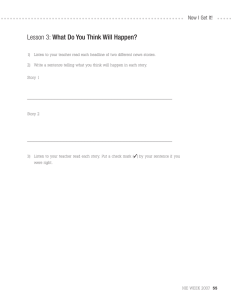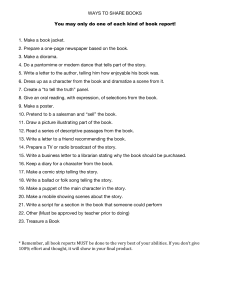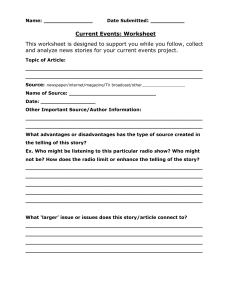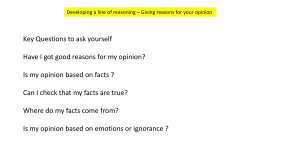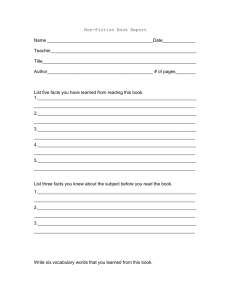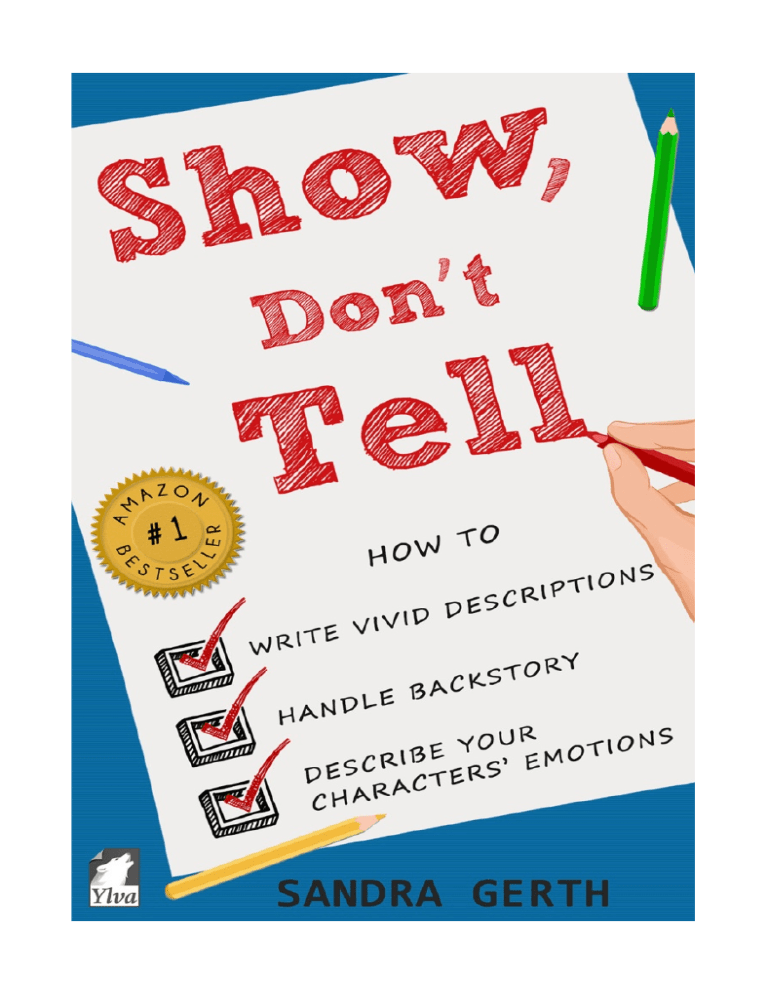
Books in the Writers’ Guide Series Goal Setting for Writers How to set and achieve your writing goals, write a book, and become a successful author Time Management for Writers How to write faster, find the time to write your book, and be a more prolific writer Show, Don’t Tell How to write vivid descriptions, handle backstory, and describe your characters’ emotions Point of View How to use the different POV types, avoid head-hopping, and choose the best point of view for your book Table of Contents 1. Introduction — What this book will teach you..................................................... 1 2. Definition — What show, don’t tell means............................................................ 5 3. The importance of showing — Why showing is usually better than telling..... 9 4. Nine red flags for telling — How to tell when you’re telling............................. 11 5. The art of showing — How to turn telling into showing.................................. 21 6. Redundancies — How to avoid telling what you have already shown............. 31 7. Danger area 1 — How to handle backstory......................................................... 35 8. Danger area 2 — How to handle descriptions..................................................... 45 9. Danger area 3 — How to describe emotions....................................................... 53 10. Telling in dialogue — How to recognize and fix it........................................... 65 11. Overshowing — How to avoid showing too much.......................................... 71 12. The uses of telling — When telling is the better choice.................................. 77 13. Exercises — How to exercise your showing skills............................................ 89 14. Solutions — How to rewrite the telling in chapter 13...................................... 91 15. Conclusion — What to do now........................................................................... 95 About Sandra Gerth Other books from Ylva Publishing 1. Introduction — What this book will teach you “Show, don’t tell” is probably the single piece of writing advice that beginning writers hear most often from editors and writing coaches. Authors who master this important technique take their writing to the next level and captivate their readers with powerful scenes that keep them turning pages even though it’s two in the morning and they have to work the next day. But many writers struggle to understand this principle or have difficulty applying it to their own work. Even authors who have already published several books often don’t grasp the finer nuances of showing vs. telling. I know because I was one of them. When I had a few books under my belt, I thought I knew what showing meant. But then I realized that I had only just scratched the surface. With every novel I wrote and every book about writing I read, I deepened my understanding and discovered more layers to show, don’t tell. As an editor and a mentor, I try to teach my writers what I learned about showing and telling. Since there are only so many writers I can mentor and only so many manuscripts I can edit, I decided to write a book about show, don’t tell so I can help more writers of all skill levels understand this powerful principle and apply it to their work. Sandra Gerth Whether you’re a novice writer working on your first story or an established author who has already learned the basics of showing and telling, this book will help you to: • • • • • • • • • • • • • grasp the difference between showing and telling; understand why showing is such a powerful tool; spot telling in your own manuscript; fix bland passages and turn them into compelling scenes; keep from telling what you have already shown; avoid the three danger areas of telling; describe your characters and your setting in interesting ways; put powerful emotions into your writing; incorporate backstory into your novel without resorting to telling; recognize telling in dialogue; avoid overshowing and swamping your readers with too many details; learn when telling is actually a good thing; immerse your readers into your story and keep them captivated from beginning to end. HOW TO GET THE MOST OUT OF THIS BOOK The only way to improve your writing is by writing, so this book includes not only concrete examples but also exercises so you can practice what you’re learning—using your own work in progress, if you want. I suggest that you print out the first chapter of your manuscript. Get a notebook or several sheets of paper and a pen and some highlighters. While you’re reading this book, stop after every chapter and do the exercises. Most of them will have you work on your 2 Show, Don’t Tell manuscript, so by the time you finish this book, you’ll have a first chapter that is full of good writing that shows instead of tells. Then you can use the techniques you learned on the rest of your manuscript too. If you don’t yet want to practice on your own manuscript—or you don’t have a completed first draft yet—there are also twenty exercises in chapter 13 that will help you practice your showing skills. By the way, a few of the examples I use throughout this book are from my own novels, written under my pen name, Jae (jae-fiction. com). I do that strictly for legal reasons, to make sure I’m not violating anyone’s copyright. A few of the examples are based on manuscripts I edited, rewritten to protect the innocent. Happy reading and writing! Sandra Gerth 3 2. Definition — What show, don’t tell means At some point in their writing career, all writers get the advice to show, not tell. “Show us that she’s a spoiled little girl; don’t tell us!” “Show us that he lives in a run-down apartment building; don’t tell us!” “Show us that she’s angry at her father; don’t tell us!” While that’s certainly good advice, many writing coaches, instructors, and editors fail to explain what it means. So, let’s start by defining showing and telling. • Telling means that you—the author—give your readers conclusions and interpretations; you tell them what to think instead of letting them think for themselves. Showing means that you provide your readers with enough concrete, vivid details so that they can draw their own conclusions. • Telling is like giving readers a secondhand report afterward. Showing lets readers experience the events firsthand, through the five senses of the character. Sandra Gerth • Telling is like reading about an accident in the newspaper the day after it happened. Showing is like witnessing the accident the moment it happens, hearing the screech of the metal and the screams of the injured. • Telling summarizes events that happened in the past or gives general statements that don’t happen at any specific time. Showing lets readers witness events in real time, in actual scenes with action and dialogue. We stay in the present, firmly rooted in the POV character’s experience. • Telling is abstract. Showing creates a concrete, specific picture in the reader’s mind. • Telling gives you facts. Showing evokes emotions. • Telling is also called narrative summary. Showing is dramatization. • Telling distances readers from the events in the story and from the characters and makes them passive recipients of information. Showing involves readers in the story and makes them active participants. 6 Show, Don’t Tell AN EXAMPLE Okay, now that I’ve told you what the difference is, let me show you by giving you an example: Tina was angry. This is telling. The author is handing readers a conclusion. Tina slammed the door shut and stormed into the kitchen. “What the hell were you thinking?” This is showing. It gives the readers the concrete actions and the character’s dialogue so that they can come to the conclusion that Tina is angry without the author stating it flat-out. 7 Sandra Gerth EXERCISE #1: • Get out a notebook or a sheet of paper and try your hand at the “Tina was angry” sentence. How would you show your readers that Tina is angry without stating her emotions? Use actions, body language, and dialogue to show her anger. 8 3. The importance of showing — Why showing is usually better than telling Telling isn’t always bad. As we’ll see in a later chapter, it definitely has its uses, but most of the time, you want to show. Why? Think about why we read novels. Unlike readers of nonfiction, fiction readers don’t read to get information. They read to be entertained and to escape into another world. The same is true for people who want to see a movie (not a documentary). Now imagine you are sitting in a movie theater, waiting for the movie to start, and instead, the person sitting next to you tells you all the interesting parts. I bet you wouldn’t be happy, right? You didn’t want to be told about the movie; you wanted to watch the movie for yourself and get so caught up in it that you forget everything else for a while. Well, readers are the same. They want to experience the story for themselves and share the characters’ struggles—and that can be achieved only with showing, not telling. Telling doesn’t evoke images in the reader’s mind. It interprets the information for the reader and robs them of the opportunity to think and discover the story world for themselves. Sandra Gerth Showing keeps readers actively engaged because they need to think about what they’re reading and interpret what’s going on rather than passively being presented with conclusions. That’s what draws them in and keeps them turning the pages because they’re actively asking questions and read on, curious to find out the answers. So to fully immerse your readers into your story and make them experience the events along with the protagonist, you need to master the skill of showing. 10 4. Nine red flags for telling — How to tell when you’re telling Now you know what telling is. But despite that knowledge, it can still be difficult to recognize when those telling instances have somehow crept into your own manuscript. Here are some red flags that indicate telling. To spot telling, read every sentence you wrote carefully. Keep an eye out for places where you find yourself using one of these red flags for telling. 1) Conclusions If you give your readers conclusions, you are telling. To show, provide them with enough “evidence” so they can come to the conclusions themselves. Example: Telling: It was obvious that he was trying to pick a fight. As you can see, that’s a conclusion. Think about how you could show your readers what it was that made it so obvious that he was trying to pick a fight. Sandra Gerth Showing: “What did you just say?” Snarling, he stepped forward, right into John’s space. Showing gives us a description of action, body language, facial expressions, and dialogue so that we can conclude that he’s trying to pick a fight without the author outright telling us so. 2) Abstract language If you are using abstract, vague language, you are telling. Take a look at each of your sentences. Can you visualize what’s happening? Could you film it? Or maybe, for the people who are familiar with Star Trek, a better question would be: could you experience it on a holodeck, since scent, taste, feel, and temperature can’t be captured on film. If you can’t experience it, you are telling. Example: Telling: She checked the man’s vital status. What exactly does “vital status” mean in this context? And what did she do to check it? We’re not getting a mental image from this vague description. Showing: She bent and placed two fingers on his neck. A faint pulse throbbed beneath her fingertips. 3) Summaries If you sum up what happened, you’re telling. Sometimes, I come across a manuscript that reads like a synopsis and that sums up everything that is happening instead of showing it in actual scenes. That’s fine if you are actually writing a synopsis, but not for your novel. 12 Show, Don’t Tell Readers don’t just want to get a general idea of what happened; they want to see specific details. Example: Telling: I found the body in the back of a tarp- covered truck. If this is a mystery novel or a scene of high emotion in which the protagonist finds a dead body, readers want to see that suspenseful moment, but found the body doesn’t create an image in the reader’s mind. Showing: I climbed onto the back of the truck and peeled back the tarp. A sickeningly sweet stench made me stumble back. Sightless eyes stared back at me. I pressed a hand to my mouth, smothering a scream. If you’re not sure if you are showing detailed actions or summing them up, try to act out what your characters are doing. If you can’t, you’re telling. As you might have noticed, the previous example also makes good use of the senses, not just sight but also smell and sound (if you count the smothered scream). Example: Telling: The dog attacked. She tried to defend herself. What exactly did the dog do? Jump? Bite? Growl? And how exactly did she defend herself ? Kick the dog? Hide? Showing: The dog leaped, canines bared. She threw up her arm to protect her throat. 13 Sandra Gerth 4) Backstory If you report things that happened in the past, before this very moment, you are telling. For important scenes, show your readers what is happening as it’s happening, in real time, instead of summing up what happened a few minutes ago. A good indicator for when you might be reporting things that happened in the past is if you find yourself using the past perfect (see the had tested in the example below). To find places where you might have used too much backstory, type had into the search box of your writing software and look for paragraphs with verbs in their past perfect form. See if you can rewrite and show us the scene in simple past tense. Example: Telling: I had tested the car to see if it would start. It didn’t. Showing: I turned the key in the ignition. A click-click-click-click noise drifted up from the engine. I smashed my fist into the steering wheel. “Dammit!” 5) Adverbs If you find yourself using an adverb, you are usually telling. Whenever possible, cut the adverbs. Sometimes, the sentence is just fine without it; other times, you might want to rewrite the sentence and replace the weak verb/adverb combination with a stronger verb that makes the adverb unnecessary. Of course, you shouldn’t cut all adverbs from your writing, but use them sparingly. Example 1: Telling: The dog tucked its tail between its legs and whined anxiously. 14 Show, Don’t Tell Showing: The dog tucked its tail between its legs and whined. The posture and whining shows the dog’s anxiety, so there’s no need to add the adverb. Example 2: Telling: “Don’t lie to me,” she shouted angrily. Showing: “Don’t lie to me, dammit.” She slammed her palm on the table. Her word choice and her action show that she’s angry, without stating the emotion. Example 3: Telling: Tina slowly walked down the street. Showing: Tina strolled down the street. The adverb (slowly) tells your readers how Tina walks; the strolled shows it. 6) Adjectives Like adverbs, adjectives can also be telling, especially if they are abstract adjectives such as interesting or beautiful. Example: Telling: I was afraid. Showing: Oh God, oh God, oh God. My knees felt like squishy sponges as I fled down the stairs. 15 Sandra Gerth 7) Linking verbs Adjectives can often be found in combination with linking verbs. Linking verbs are verbs that connect a subject with an adjective or noun. Examples are was/were, is/are, felt, appeared, seemed, looked. The problem with them is that they are weak, static verbs that don’t show us an action. Replace most of them with more active verbs. Examples (with the linking verbs set off in italics): Telling: It was cold. Showing: She breathed into her hands to warm her numb fingers. Telling: Tina felt tired. Showing: She rubbed her eyes. Telling: Tina seemed impressed. Showing: Tina’s eyes widened, and her lips formed a silent, “Wow!” Telling: Tina looked as if she was going to cry. Showing: Tina’s bottom lip started to quiver. 8) Emotion words When you’re naming emotions, you are telling. Keep an eye out for adjectives such as “surprised” and “angry” and nouns such as “amazement” and “confusion.” You might even start a list of the emotion words you use most often, to make sure you can catch them during the revisions. Instead of naming emotions, use actions, thoughts, visceral reactions, and body language to show what your characters are feeling. More on that in the chapter on showing emotions. 16 Show, Don’t Tell Example: Telling: When relieved. John left, Betty and Tina were Showing: When the door closed behind John, Betty wiped her brow and Tina exhaled the breath she’d been holding. At times, naming an emotion can work, though, if you make the emotion word the sentence’s subject and pair it with a strong verb. But use this technique sparingly, or it will start to jump out at the reader. Example : Fear clawed at her like a wild animal. 9) Filters Filter words are verbs that describe the character perceiving or thinking something, for example, saw, smelled, heard, felt, watched, noticed, realized, wondered, and knew. The problem is that filter words tell your readers what the character perceives or thinks instead of letting them experience it directly. Readers are forced to watch the character from the outside instead of being in her head, experiencing things along with her. So, cut out the “she realized” and “he saw” and make the sentence just about the thing she realized or the sound he heard. Examples: Telling: Tina heard Betty suck in a breath. Showing: Betty sucked in a breath. 17 Sandra Gerth Telling: Tina realized she had lost her keys. Showing: Tina patted her pockets. Nothing. Oh shit. Where were her keys? Here, we—the readers—get to witness the realization without the author telling us she had a realization. REVISION TIP For some of these red flags, you can use the search feature of your writing software to find and replace them. • To find adverbs, type ly into the search box, or if you know which adverbs you overuse, e.g., quickly, softly, gently, do a search for them. • You can also search for filter words such as wondered, realized, or heard. • For emotion words, type in the noun, adjective, and adverb form of emotions such as anger, angry, and angrily. • Also search for linking verbs such as felt, was, or seemed. Revise each of them and turn telling into showing, using the tips and examples above to guide you. 18 Show, Don’t Tell EXERCISE #2: • Print out the first scene of your work in progress and read it line by line. Can you detect any of the red flags for telling? Can you picture everything you have described, or have you used abstract words, for example? • If you are working on your computer or laptop, use the find feature to search for red flags such as adverbs, emotion words, and filters, as described above. If you use pen and paper, try to spot any adverbs, adjectives, filters, or emotion words in the scene. • Have you used past perfect, which can be a red flag for telling readers about things that happened in the past? • Highlight all instances of telling that you can find in your first scene. 19
